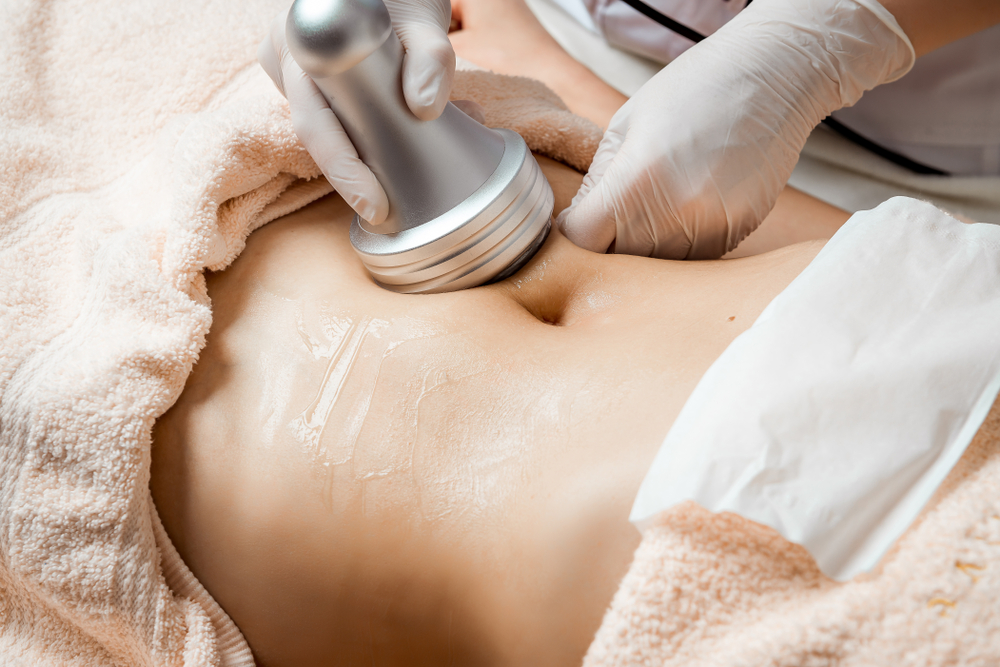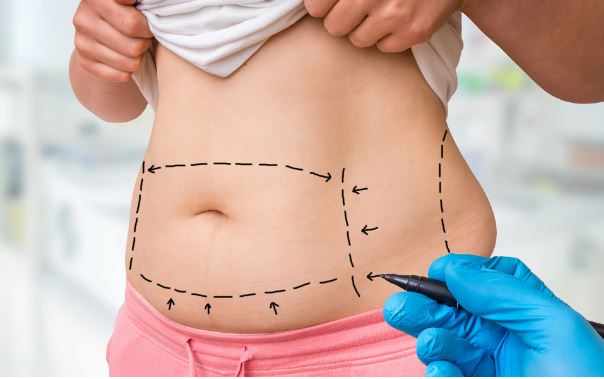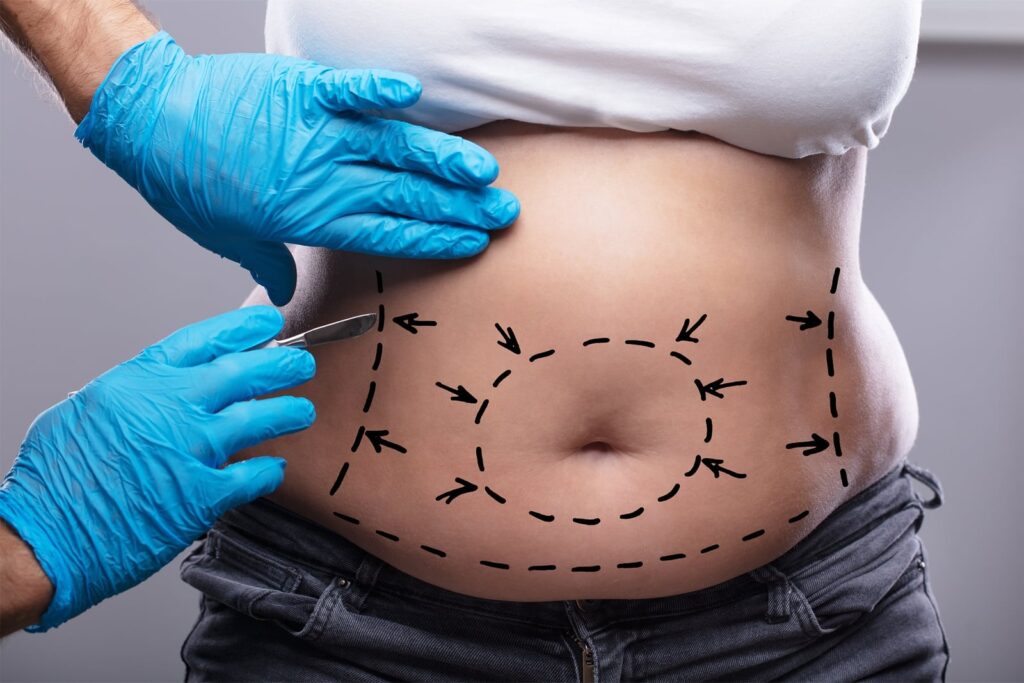Introduction
Liposuction is a subject of fascination for those seeking fast solutions for body fat. Although it is a popular procedure, there are still many who wonder what weight you really lose through the procedure. This blog explores How Much Weight Can You Lose With Liposuction and the reality of liposuction and its purpose and limitations based on research as well as research studies.
Before making any decisions regarding the procedure, it’s important to know what liposuction is and can’t accomplish. Let’s go through it in steps.

The Problem: Weight Loss Expectations and Liposuction Myths
Liposuction is commonly advertised as a way to eliminate fat, which is why many believe that it is a feasible method to achieve large weight reduction. But this is an error. The purpose of liposuction is to shape the body by eliminating the accumulation of fat, but it is not a replacement for diets or working out.
There are a number of myths surrounding liposuction, such as the notion that it is able to remove massive quantities of fat or cause weight loss without any effort. The misunderstandings could lead to frustration with the outcome along with financial burdens as well as health risks when patients undergo this procedure with unreasonable expectations.
Agitation: Why Misunderstanding Liposuction’s Role is a Problem
If people mistake liposuction for the procedure to lose weight, it may result in poor choices. One of the most common complaints for people is that, despite performing liposuction, the scale isn’t a clear indication of a substantial loss in weight.
Additionally, the idea that liposuction will prevent weight loss is a different myth. If you do not make lifestyle adjustments, the weight gain can occur, and is often dispersed differently across the body. This raises the need to be more aware of the process.
The Solution: Understanding Liposuction’s Role and Realistic Outcomes
The procedure is cosmetic and is not an effective tool for weight loss. On average, patients anticipate losing anywhere from 1 and 10 pounds of excess fat, dependent on the area that is treated as well as the quantity of fat that is removed. We’ll explore this issue in greater depth with the help of data as well as real-world case studies.
How Much Weight Can Liposuction Remove?
Experts and research prove the fact that liposuction reduces volume but not always “weight.” In general, surgeons suggest eliminating no more than 5 pounds of fat in a single procedure, which is about 10 pounds. This varies the body’s composition and the area of treatment.
A review published in Plastic-and-Reconstructive-Surgery found that, while the patients shed excess fat, their total weight loss was not as significant in comparison to the results they could accomplish with other methods of weight loss.
When I first thought about the idea of liposuction, I thought that it would make a huge difference in weight. I was thinking, “If I remove fat from my abdomen and thighs, won’t I drop 20 pounds or more?” After speaking with an expert, I realized it wasn’t true. The term “liposuction” is more about inches rather than pounds.
Body Contouring vs. Weight Loss
The body is transformed by targeting fat pockets in specific areas that resist exercise or diets. The procedure is perfect for individuals who are close to their ideal weight, but having trouble with abdominal areas and thighs or the arms.
Many patients notice that their clothing fits more comfortably, as well as they have more proportionate shapes. But, this may not translate into any significant weight loss or reduction on a scale.
After consulting I realized that the procedure of the procedure is similar to the art of fine-tuning. It’s about shaping your body and not altering your total dimensions. A new outlook changed the way I made my decisions.

How Long Do Results Last?
It removes the fat cells permanently from the area treated. However, it does not stop the formation of new fat. If patients gain weight after the procedure, excess fat could be accumulated in non-treated areas. Being able to maintain a steady weight with good habits is essential for lasting results.
A 2021 study published in the Aesthetic Surgery Journal showed that patients who combined liposuction with lifestyle adjustments and consistently exercising reported greater satisfaction as compared with those who did not.
It was time to consider, “Am I ready to commit to a healthier lifestyle?” The surgery wasn’t only about me but also about maintaining your results following surgery. Liposuction was not a miracle cure it was a collaboration using my effort.
Who is a Good Candidate for Liposuction?
It is the most efficient treatment for those who
- Reaching 30-70% of their ideal body weight.
- No serious medical problems.
- The focus is on improving the contours of your body and not making huge weight reduction.
It is not suggested for the treatment of weight gain or as a replacement for healthy living. Patients must be realistic about their expectations as it enhances instead of transforming the body.
Making realistic goals was more difficult than I anticipated. I was forced to face my fears and be honest with myself. I also did not compare myself to images on the internet. The surgeon I saw helped me see the things that could be done and the things that weren’t.
The Psychological Impact of Liposuction
Patients often report increased confidence after having liposuction because of increased body proportions. However, unrealistic expectations could cause dissatisfaction, even having excellent results.
The study of 2020 found that patients focusing on improving certain areas of concern had a higher likelihood of feeling satisfied with the results as opposed to those who were expecting massive transformations.
After the procedure was completed, I noticed an improvement in the way I felt my clothing. It was a subtle change that gave me confidence and self-confidence even though my weight was not drastically changed.
Risks and Recovery
Although liposuction is thought to be secure, the possibility of infections, irregular contours, or complications from anesthesia is present. The recovery process typically causes bruises, swelling as well as mild discomfort for several weeks. Follow the instructions of your surgeon post-operatively is essential for optimum outcomes.
Recovery wasn’t all smooth. The swelling did me awe initially, and I needed to remind myself that the result wouldn’t be evident in a matter of minutes. It was important to be patient.
What exactly is liposuction?
The Liposuction is a surgical technique used to eliminate excess fat accumulations from specific regions of the body. The method uses suction to eliminate fat cells, aiding in contouring and shaping the physique. The most common areas to be treated with liposuction are the thighs, abdomen as well as hip, hip, arms, and chin. It’s not a weight-loss method. However, it can be effective in treating localized fats that don’t respond to exercise or diet.
How is liposuction performed?
This procedure involves inserting the cannula through tiny incisions cut into the skin, and then connecting it to an extractive vacuum device, also known as a syringe. This device extracts fat cells.. There are various types of liposuction methods, such as the tumescent method, ultrasound-assisted liposuction (UAL) as well as laser-assisted procedure of liposuction (SmartLipo). The technique used is based on the goals of the patient and the recommendation of a surgeon.

Are liposuction procedures safe?
It is usually risk-free when it is performed by an experienced and certified plastic surgeon who is certified and experienced. Like any surgical procedure is not without risk, including bleeding, infection, or anesthesia-related complications. It is important to ensure that the surgeon has been certified by the board and follows every procedure, both pre-and post-operatively, to reduce the risk. The advancements in technology and methods have dramatically enhanced the safety of liposuction, especially in the past few years.
What are the advantages of the procedure of liposuction?
The main benefit of liposuction lies in improved physique contours and proportions. It’s a great way to eliminate stubborn spots of fat, boost confidence and self-esteem, as well as make clothing look better. In contrast to non-invasive techniques for fat reduction that are non-invasive, liposuction can provide immediate and tangible effects.
Who’s a suitable patient for liposuction?
The ideal candidates for liposuction include:
- A little less than 30 percent of their ideal weight.
- Overall, health is in good condition, free of any significant medical problems.
- Smokers who do not (or who are willing to stop smoking before and following the procedure).
- Patients with firm, elastic skin with localized fat deposits that resist exercise and diet.
- Be aware of what this procedure could achieve.
The procedure isn’t suitable for patients looking for an answer to obesity or weight reduction.
What is the cost of liposuction?
The price of liposuction can vary depending based on the factors involved, such as the area of treatment and the experience of the surgeon, the location of the surgery, as well as the extent to which multiple regions are addressed. Within the U.S., the average costs range from $3500 to $8,000 per region, which excludes the cost of anesthesia, hospital charges, and post-surgical clothes.
What body areas could be treated by liposuction?
The procedure can be done on nearly any region of the body where stubborn fat is accumulating. The most frequent areas of treatment are:
- Abdomen
- Thighs (inner and out)
- The hips and the flanks
- Upper arms
- The bra rolls back, and the back
- Chin and neck
- Buttocks
- Ankles and calves: The selection of the area is based on the goals of the patient and the surgeon’s evaluation.
How much fat is taken out through using liposuction?
The amount of fat eliminated in liposuction can vary, but the majority of surgeons stick to the safe limit. The majority of the time, as much as 5 Liters of fat (approximately 10 pounds) are safely removed during one procedure. The removal of more fat could cause more risk and problems. The aim isn’t to get rid of all fat but rather to increase body proportions.
Does liposuction make me prone to loose skin following the procedure?
The loose skin following liposuction is contingent on the elasticity of the skin and also the quantity of fat eliminated. If the skin is elastic and has elasticity, it’s likely to be able to retract in order to accommodate the contours. However, those with large amounts of fat removed or weak elastic skin may have wrinkles or skin that is loose. In these cases, other procedures, such as a tummy tuck or tightening of the skin, may be suggested.
Does liposuction help remove stretch marks?
Liposuction doesn’t remove stretch marks since it targets fat underneath the skin and not even on the surface of your skin. The stretch marks are caused by thinned skin and damaged skin, typically due to rapid stretch during weight gain or pregnancy. Although liposuction can enhance the look of the stretch marks by changing the shape of the affected area, however, it isn’t going to eliminate them.

Conclusion
Liposuction is a great technique for shaping your body. However, it’s not a weight loss treatment. The majority of patients shed between one to 10 pounds by sculpting certain regions rather than a significant weight loss.
To ensure long-lasting results, you need to incorporate liposuction into the right way of life. Making realistic targets and understanding what the procedure’s goal is going to help to approach the procedure confidently and clearly. Keep in mind that the secret to your satisfaction is making sure you are aligned with the goals the procedure was designed to accomplish.
Liposuction isn’t just concerned with losing fat. It’s also about the confidence that you build.
FAQS
How much weight could be lost through using liposuction?
The typical result of liposuction is losses of one up to 10 pounds based upon the amount of fat that is removed.
Does liposuction count as a method to lose weight?
It’s an exercise for body contouring that aims to eliminate fat deposits in specific areas and is not a method to lose weight.
Will liposuction be able to remove all excess fat in an area?
Liposuction eliminates a small amount of the fat that is removed from a part but doesn’t eliminate the entire fat. Certain fats are left to natural lines.
What amount of fat is safe to be trimmed in one session?
The majority of surgeons limit the removal of fat to 5 milliliters (approximately 10lbs) in order to protect themselves.
Is the fat reabsorbed following the procedure?
Liposuction removes fat cells, and they will remain gone forever. Yet, new fat could develop if a healthy diet doesn’t last.
Can liposuction be used to tighten loose skin?
Liposuction does not tighten skin. If fat has been eliminated and the skin’s elasticity is weak, loose skin could result.
Are there any side effects from liposuction?
The use of anesthesia diminishes the pain during surgery. After-surgery discomfort can be moderate and can be controlled with medications.
How long will it take to notice the effects of liposuction?
The first signs of improvement are apparent when the swelling has subsided, typically in 4 to six weeks. Results may last as long as 6 months.
Do I gain weight following the procedure?
If you eat too many calories or exercise less, weight gain may occur; however, it might be distributed in different ways.
Who is not a candidate for the procedure?
Liposuction is not advised for people with severe health problems, obesity, or who have unrealistic expectations regarding its outcomes.

